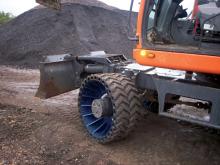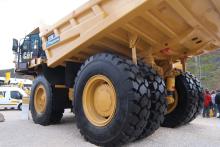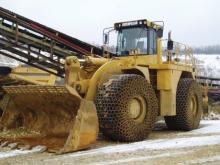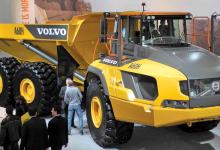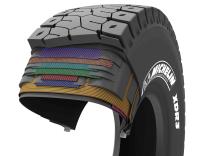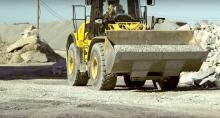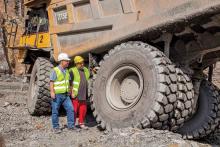Difficulty in obtaining tyres for quarry machines means that more attention is focused on proactive maintenance to improve service life
While the use of shredded tyres to power cement plants means that used tyres no longer have to be sent to landfill, the sourcing of new tyres to replace them is still a challenge.
The shortage of off the road (OTR) tyres has been a problem for the construction equipment industry for several years and the problems look set to continue until at least 2010. Although shortages in some sizes are now beginning to ease through investment in new production facilities now coming online, the shortage in the larger sizes used in quarrying applications is still a reality.
The supply problems were caused by a combinations of factors - the global construction boom of the last few years, combined with a fire at the
To cope with the shortage, many quarry operators have started to optimise the wear life of their existing tyres and, according to
Causes of damage
"There are four main factors that can cause damage to earthmover tyres - under-inflation, over-inflation, overloading and excessive speed," said Pelletier. "If a tyre is run in an under-inflated condition, the increased deflection will lead to an increase in its internal operating temperature and fatigue. But conversely, over-inflation reduces the tread contact with the ground, which leads to increased wear and reduce resistance to cuts and impact damage.
"Overloading will adversely impact on the rate of tread wear with greater deflection of the sidewalls through increased temperatures and fatigue. Excessive speed can also increase the internal tyre temperature and lead to fatigue and rapid tread wear." According to data from Michelin, overloading can have a severe impact on wear life with operation at 10% above the weight limit reducing tread life by 15%. If the overloading reaches 20%, tread life is reduced by 30% and at 30% overloading, life is reduced by 50%. Under and over-inflation can also have similarly severe impacts on wear life.
The way a machine is operated is also known to affect tyre life. "Heavy and repeated braking, rapid acceleration, cornering at high speed and spinning the tyres can all affect the life span of tyres," said Pelletier. "Internal tyre temperatures can be raised when machines are used on long cycles, especially on established haul roads, which tend to encourage high speeds. This can also be a problem where the running time is much longer than the standing time.
"Maintenance issues, such as faulty brakes, poor alignment of steer wheels and play in the suspension or hub components, can also cause tyre problems." According to Pelletier, the haul road design can also influence tyre wear by impacting on the dynamic overloading and tyre scrub depending on the length, width, camber and gradients. "Travelling downhill laden increases the load on the front axle, whereas cambered or banked curves will increase the load carried by the tyres on one side of the machine," he said. "Regular maintenance and removal of debris, along with cleaning of loading areas, can help to protect tyres from accidental damage."
Preventative maintenance
Regular checks are an essential part of efforts to prolong tyre life as it allows for assessment of tyre wear to check for early signs of damage or mechanical wear. With this knowledge it is possible to schedule repairs before the tyre fails and minimise machine downtime. According to Michelin, the systematic inspection should extend beyond just the tyres and also include the wheels, valves and valve caps.
"Safety is a key consideration when it comes to planning tyre inspections," said Pelletier. "It is preferable to check machines when they are empty but occasionally checks of fully laden machines are part of the process to ensure they are not being overloaded. It is essential that the machine operator is aware that the inspection is in progress as on some larger machines the driver may not be able to see the inspector during the process.
"For this reason it is recommended that inspections are not carried out while machines are queuing but are isolated from the operational area and a warning notice placed in view of the driver until the work is completed."
Improving performance
In some applications it is difficult to reduce the load but it is possible to adapt the machine's tyres to cope with more onerous applications through twinning or ballasting the tyres.
Twinning - mounting two tyres on the same hub of an axle - allows the vehicle to carry nearly twice as much load on that axle. Twinned tyres are mainly used on the rear axle of rigid dump trucks and at the front on some front-loading forklift trucks.
"The two tyres making up a twinned set should ideally behave like one and the same tyre," said Pelletier. "The main advantage is that they allow the vehicle to transport heavier loads and also help with repairs in the case of a puncture because the machine will not be immobilised.
"But there is also potential for debris to become trapped between the tyres, which can weaken the sidewalls, but rock ejectors can be fitted to minimise this. Service and maintenance operations also take longer to complete." According to Pelletier, for twinned tyres to work effectively they must have the same type of construction - radial or diagonal - and preferably of the same brand and type too. They must also be the same size and run at the same pressure to prevent abnormal wear.
Ballasting is also used on some machines to increase the tipping load to maximise bucket carrying capacity or to make machines more stable. Nonetheless, the technique does not improve the traction capabilities of the machine.
Ballasting can either be carried out by applying weights to the wheel or by filling the tyre with water.
"Water ballasting is usually taken to 75% and does not affect the tyre's characteristics. Taking ballasting above this level will increase the stresses exerted on the tyre," explained Pelletier. "This type of ballasting is carried out using a mix of water and a suitable non-corrosive anti-freeze to prevent damage when operating in cold conditions. The pressures on water ballasted tyres need to be carefully monitored as the volume of air used to maintain the pressure is very low."
Prolonging life
Some types of tyres that have tread wear but no significant damage can have around 20% extra service life added to them with re-grooving. "Some truck and crane tyres can be re-grooved to extend the tyre's grip potential, which helps to reduce their cost," said Pelletier. "Re-grooved tyres can be mounted on the front or rear axle and is approved under international standards because of the improved safety and cost reduction.
"The process does not impact on a tyre's suitability for later retreading and retreaded crane or truck tyres can also be re-grooved but the process should be carried out when 2 to 3mm of the tread remains to ensure the pattern can be effectively reproduced." Once the tyre has gone beyond the re-grooving stage, it can still be retreaded as long as there it has not been previously damaged and repaired. Retreading involves removing the worn out tread and replacing with a new uncured tread, which is then cured onto the tyre to give it the same properties as a new tyre.
Retreading has grown in popularity since the shortage of OTR tyres first became an issue. The shortage has meant that manufacturers have even had to supply new machines with retreaded tyres.
Damaged tyres can also be returned to service through a number of different repair options but the best solution will vary depending on both the size of the tyre and the type and location of the damage. Depending on the damage, the repair can be carried out using either hot or cold cure techniques. Cold repairs are fixed in place with rubber solution, while hot cure methods use rubber fillers and bonding rubber to fix patches into place.
Future supply
Prospects for better supply of OTR tyres in the long term looks significantly better than it has in the last few years. Demand for new machines seems to be slowing slightly with the current global financial crisis and new tyre manufacturing facilities are starting to come on stream.
Nonetheless, it is likely that quarry operators will continue working to prolong wear life even after tyre supply problems ease. Since the tyre shortage first hit the sector, quarry operators have become much more cost conscious with the rising price of fuel and a greater focus on production costs per tonne and environmental performance. But the experience of the recent problems means that quarry operators are now more aware of the tyre options open to them.


